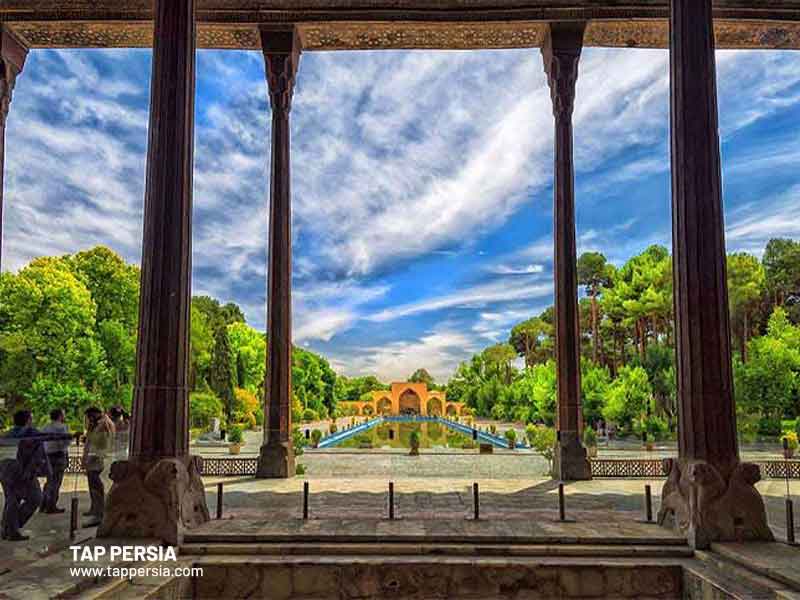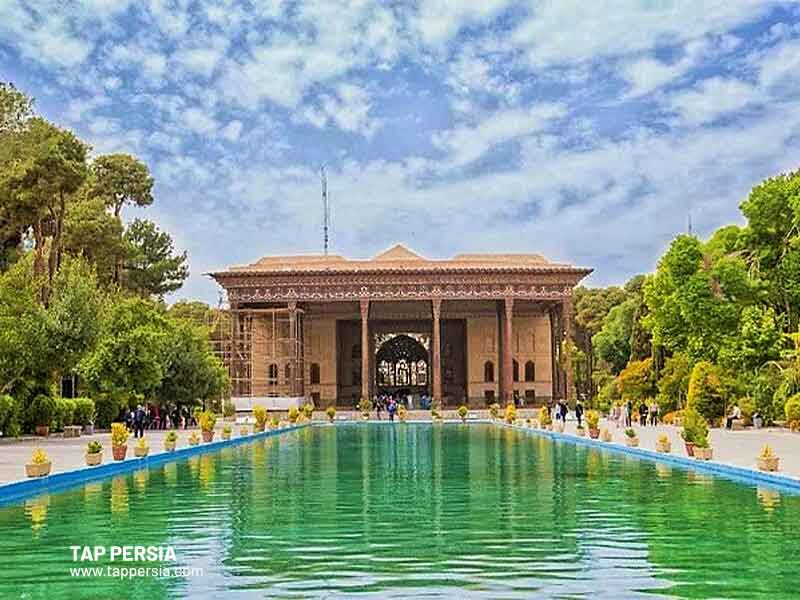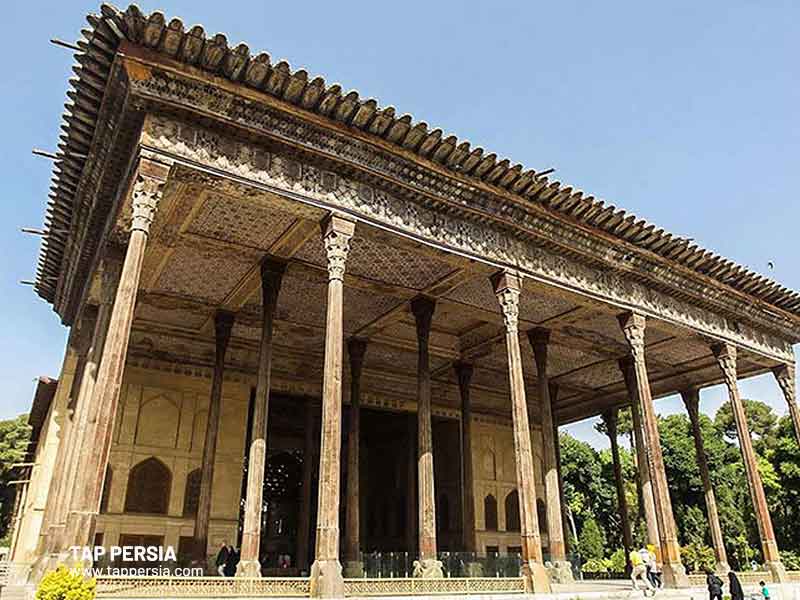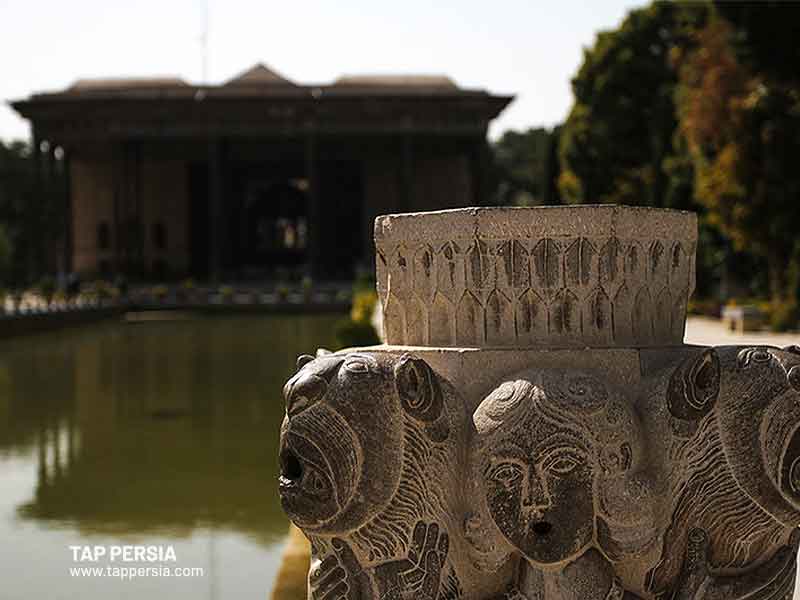One of Iran’s most exquisite structures is Isfahan‘s Chehel Sotoon (also Chehel Sotoun) Palace. The “Forty Column Palace,” also known as Chehel Sotoon, is a well-preserved reminder of the Safavid Empire’s dominion in Iran. Its amazing and distinctive 17th-century architecture amazes tourists.One of its great attractions is the magnificent mural art of Chehel Sotoun. The Chehel Sotoun Palace is one of nine Iranian Gardens that make up the Persian Garden, one of Iran’s 23 sites that have been designated as a World Heritage Site.
Location of Chehel Sotoun Palace
South of Sepah Street, East of Chaharbagh Street, and west of Naghsh-e Jahan Square are locations where you’ll find the garden in Isfahan. The garden was planned to be accessible from other gardens by being located in the city and amid other gardens. Along the Chaharbagh, a collection of beautiful gardens emerged. The garden has three entrances, all of which are on the east side.
\ A sizable pool can be seen in front of the mansion when you enter the garden through its main entrance and proceed a short distance. With the support of the trees on each side, the garden’s primary axis indicates the direction of travel toward the main palace. Its very slight slope facilitates the water’s entry into the tiny rivers.
History of Chehel Sotoun Palace
magnificent palace was built and established in the Safavid era in 1588. However, it wasn’t totally finished until 1647. Except for Hasht Behesht Garden and Chehel Sotoun Garden, none of these gardens are sadly still surviving. We shall go into this magnificent palace’s historical specifics:
History of the palace and garden

One of Isfahan’s most exquisite Safavid relics is the palace known as the most fortunate edifice in the world. One of the instances of the Safavid royal gardens, also known as the garden of the forty pillars or the museum of the forty-first sultan, is this city’s palace.It is situated in a garden that Shah Abbas II created for gatherings and entertainment. In actuality, this garden is only a tiny portion of all the beautiful and expansive gardens in the world. One of Isfahan’s most well-known and visited palaces, this historical site still has breathtaking beauty to offer visitors and tourists despite its damage.
History in the period of Shah Abbas
Isfahan expanded and flourished quickly after being chosen as Iran’s capital during the Safavid era, and numerous new structures were constructed there. The Chehel Soton garden and palace complex, whose cornerstone was placed during the reign of Shah Abbas I, was one of their most significant structures. Various accounts claim that Shah Abbas I required a modest pavilion to be built near to his formal residence during his reign. In order to avoid the bustle of the monarchy and statehood, he carried out his court duties at the palace of Aali Qapo, which took a respite.He thus gave the order to build a tiny palace in the style of a pergola with chambers that might reach a height of 12 meters in the midst of Jahannama Garden (later known as Chehel Sotoun Garden). Naturally, this estate was eventually utilized to receive diplomats, dignitaries, and Iranian and foreign politicians, as well as to organize modest gatherings. Even some historians assert that Shah Abbas I observed Nowruz in this residence in the 23rd year of his dominion. The fact that this garden once had access to all the neighboring gardens, especially those close to Naghsh-e Jahan Square and Chaharbagh Street, is useful information. A tunnel connected its center house to all of Isfahan’s palaces from that era, including Hasht Behesht and Aali Qapo.
Chehelston Palace during the reign of Shah Abbas II
It was decided to expand the home and convert it into a palace following the death of Shah Abbas I and during the coronation of Shah Abbas II. The palace and park were ornamented by the period’s artists and architects as a chance to display their fine craftsmanship and aesthetic sense.Shah Abbas II ordered the mansion’s interior and exterior walls to be covered with opulent paintings and dazzling mirrors, and he also enlarged the number of halls, chambers, and other areas. These portions include the porches on each side of the royal entrance, The Hall of Eighteen Columns, The Hall of Mirrors, the two large chambers to the north and south of the Hall of Mirrors, and the large pool in front of the Hall of Mirrors.All of these areas feature elaborate decorations, mirrors, and tiled walls and ceilings. As a result, it was one of the first structures in Iran to be lavishly decorated with grand mirrors, expansive murals, and wooden columns. Three years after Shah Abbas II’s reign began, the magnificent palace was finally inaugurated in 1056 AH (1024 SH), in his presence as well as ambassadors from other countries. The palace’s enormous rooms served as a meeting place for the monarch and a venue for formal guests to be hosted when building and ornamentation were finished.
Garden and Palace in the time of other Safavid kings

After Shah Abbas II’s rule, the garden and palace continued to serve as a venue for entertaining visitors and locals while also serving as one of Isfahan’s primary administrative and governmental structures. Of course, during Shah Sultan Hussein’s twelfth year in power, a tragic incident occurred in the palace, and this magnificent work of art and construction ended up on fire.
The Palace in the Qajar period
The construction of its palace and garden is still ancient, based on the accounts of travelers like Madame Diolafoa and Eugene Flandin, who visited Iran in 1298 AH (1259 SH) and journeyed there under the reign of Mohammad Shah Qajar. It wasn’t different; it remained unchanged. Unfortunately, Zell-e Sultan, the Isfahani king and the son of Nasser al-Din Shah Qajar, left the palace and garden’s construction in a terrible state of disrepair in 1300 AH (1261 SH). For instance, during his reign, the garden’s marble pond and stone ditches were filled with dirt, and its water channels were blocked. The following is how Madame Diolafoa described the layout of the trees and plants in the garden in her travelogues, accurately capturing the landscape during the Qajar era:During the celebrations, lights were strung from the tops of the tall sycamore trees that were situated on each side of the pool and along the main axis. Regardless of substance or color, flowers of all kinds blossomed in the plots (garden) at their feet. Fruit plants may be observed inside the plots as well.The intensity of Safavid architectural destruction and neglect had grown as the end of the Qajar dynasty drew near. The splendid palaces of Chehel Sotoun and Aali Qapu had been reduced to ruins by the end of this time. For instance, they painted the palace’s walls again this time using oil paint.As a result, the paintings beneath the palace began to disintegrate and split from the wall. This building’s other embellishments and its inlaid doors were not protected from this terrible onslaught, and they both sustained significant damage.Sheikh Jaber Ansari claims that the mirrors that could distinguish between people up to 180 meters away from the palace were taken out and transported to Tehran’s Masoudiyeh Mansion together with the Khatam doors and artwork.He said that between 1298 and 1305 AH, the double-sided carpet that was once in this palace was pulled to pieces and destroyed (1260 to 1267 SH). Another catastrophe that befell the palace was the repainting of the murals, this time with cement.
Pahlavi period
During the Pahlavi period, the palace’s condition much improved, and an Italian archaeological institution was hired to complete the repair. The institution restored the paintings and sketches that were covered behind the plaster by using ancient images of the castle to recreate new doors and windows in the traditional manner. Following these improvements, the palace was transformed into a museum and housed significant artwork from many historical eras.
Structure of Chehel Sotoun Palace

On a plot of land of 67,000 square meters, stands Chehel Sotoun Palace. The architecture of China, Iran, and Europe served as inspiration for its design. A balcony with 20 cypress wood columns greets you as you enter the palace. But there must be 40 columns, as the name Chehel Sotoun indicates.The 20 actual columns are reflected in the pool’s water, giving the appearance of 40 columns. It’s important to note that in Iran, the number 40 represents diversity in general. Therefore, we might infer that there was a lot of thought put into creating such a magnificent construction.Additionally, fretworks and cachet motifs are used to embellish all of the doors and windows. The palace’s main hall also has several opulent paintings on the walls, each of which alludes to a noteworthy occasion that occurred at a certain epoch. All of these components demonstrate the competence of Iranian masters and architects.
Where to Eat near Chehel Sotoun Palace
After touring this magnificent palace, you may find a variety of restaurants around where you can have delectable dishes. So try these top restaurants and experience mouth-watering Persian cuisines in Isfahan. These eateries are as follows:Shahrzad Restaurant, Azam Beryani Restaurant, Grandma’s Table Restaurant, Adak Fast Food Restaurant, Venice Restaurant, Malek Soltan Jarchibashi Restaurant, Nobahar Restaurant, Bakhtiari Restaurant, Hakim Bashi Persian Restaurant, and Saraye Simorgh Restaurant.
Where to Stay near Chehel Sotoun Palace
For guests who are worried about the distance, there are a number of hotels near to Chehel Sotoun Palace. These hotels include the AliQapu Hotel (4-Star), Piroozi Hotel (4-Star), Safavi Hotel (3-Star), Tourist Hotel (3-Star), and Partikan Hotel (1-Star) (5-star).While visiting Isfahan, spend a few nights at one of these hotels to make some amazing memories. We also suggest that you visit our page featuring the Top 10 Cheap Hotels (Hostels) in Isfahan if you’re looking for a place to stay on a tight budget.
How to Get to Chehel Sotoun Palace?

You simply need to travel to Isfahan’s Dolat Gate Square if you want to find out how to get to Chehel Sotoun Palace. Fortunately, the city of Isfahan’s public transit system has made your job simple, and you may get out at the Imam Hossein metro station or Imam Hossein bus station to visit this stunning location.
Who built Chehel Sotoun?
Shah Abbas was an Iranian King during the Safavid dynasty who built this amazing palace.
What is the meaning of chihil Sutun?
Chihil Sutun, or Chehel Sotoun, means “40 Columns” in the Persian language.




Comment (0)